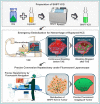Superstable homogeneous lipiodol-ICG formulation: initial feasibility and first-in-human clinical application for ruptured hepatocellular carcinoma
- PMID: 36683740
- PMCID: PMC9847516
- DOI: 10.1093/rb/rbac106
Superstable homogeneous lipiodol-ICG formulation: initial feasibility and first-in-human clinical application for ruptured hepatocellular carcinoma
Abstract
The most common treatment of spontaneous tumor rupture hemorrhage (STRH) is transcatheter arterial embolization (TAE) followed by liver resection, and surgical navigation using near-infrared fluorescence is effective method for detecting hidden lesions and ill-defined tumor boundaries. However, due to the blockage of the tumor-supplying artery after effective TAE treatment, it is difficult to deliver sufficient fluorescent probes to the tumor region. In this study, we report on the successful application of superstable homogeneous intermixed formulation technology (SHIFT) in precise conversion hepatectomy for ruptured hepatocellular carcinoma (HCC). A homogeneous lipiodol-ICG formulation obtained by SHIFT (SHIFT-ICG) was developed for clinical practice for STRH. A ruptured HCC patient received the combined protocol for embolization and fluorescence surgical navigation and exhibited excellent hemostatic effect. Lipiodol and ICG were both effectively deposited in the primary lesion, including a small metastatic lesion. In follow-up laparoscopic hepatectomy, SHIFT-ICG could clearly and precisely image the full tumor regions and boundaries in real time, and even indistinguishable satellite lesions still expressed a remarkable fluorescence intensity. In conclusion, the simple and green SHIFT-ICG formulation can be effectively used in emergency embolization hemostasis and later precise fluorescence navigation hepatectomy in patients with ruptured HCC bleeding and has high clinical application value.
Keywords: conversion therapy; fluorescent navigation; hepatectomy; spontaneous tumor rupture.
© The Author(s) 2022. Published by Oxford University Press.
Figures






Similar articles
-
An exploratory human study of superstable homogeneous lipiodol-indocyanine green formulation for precise surgical navigation in liver cancer.Bioeng Transl Med. 2022 Sep 10;8(2):e10404. doi: 10.1002/btm2.10404. eCollection 2023 Mar. Bioeng Transl Med. 2022. PMID: 36925696 Free PMC article.
-
A superstable homogeneous lipiodol-ICG formulation for locoregional hepatocellular carcinoma treatment.J Control Release. 2020 Jul 10;323:635-643. doi: 10.1016/j.jconrel.2020.04.021. Epub 2020 Apr 14. J Control Release. 2020. PMID: 32302761
-
A pure nanoICG-based homogeneous lipiodol formulation: toward precise surgical navigation of primary liver cancer after long-term transcatheter arterial embolization.Eur J Nucl Med Mol Imaging. 2022 Jul;49(8):2605-2617. doi: 10.1007/s00259-021-05654-z. Epub 2021 Dec 23. Eur J Nucl Med Mol Imaging. 2022. PMID: 34939176
-
Spontaneous ruptured hepatocellular carcinoma.Hepatol Res. 2016 Jan;46(1):13-21. doi: 10.1111/hepr.12498. Epub 2015 Mar 2. Hepatol Res. 2016. PMID: 25631290 Review.
-
Laparoscopic Left Hepatectomy for Ruptured Hepatocellular Carcinoma Controlled After Transcatheter Arterial Embolization: Case Report and Review of the Literature.In Vivo. 2018 May-Jun;32(3):659-662. doi: 10.21873/invivo.11290. In Vivo. 2018. PMID: 29695575 Free PMC article. Review.
Cited by
-
An injectable and dual-crosslinked hydrogel for controlled and permanent vascular embolization.Bioact Mater. 2025 Jul 9;53:141-160. doi: 10.1016/j.bioactmat.2025.06.049. eCollection 2025 Nov. Bioact Mater. 2025. PMID: 40688022 Free PMC article.
-
Fluorescence-guided Surgery for Hepatocellular Carcinoma: From Clinical Practice to Laboratories.J Clin Transl Hepatol. 2025 Mar 28;13(3):216-232. doi: 10.14218/JCTH.2024.00375. Epub 2025 Jan 2. J Clin Transl Hepatol. 2025. PMID: 40078203 Free PMC article. Review.
-
Supercritical Fluids: An Innovative Strategy for Drug Development.Bioengineering (Basel). 2024 Aug 4;11(8):788. doi: 10.3390/bioengineering11080788. Bioengineering (Basel). 2024. PMID: 39199746 Free PMC article. Review.
References
-
- Kneuertz PJ, Demirjian A, Firoozmand A, Corona-Villalobos C, Bhagat N, Herman J, Cameron A, Gurakar A, Cosgrove D, Choti MA, Geschwind JF, Kamel IR, Pawlik TM.. Diffuse infiltrative hepatocellular carcinoma: assessment of presentation, treatment, and outcomes. Ann Surg Oncol 2012;19:2897–907. - PMC - PubMed
-
- Aoki T, Kokudo N, Matsuyama Y, Izumi N, Ichida T, Kudo M, Ku Y, Sakamoto M, Nakashima O, Matsui O, Makuuchi M; Liver Cancer Study Group of Japan. Prognostic impact of spontaneous tumor rupture in patients with hepatocellular carcinoma: an analysis of 1160 cases from a nationwide survey. Ann Surg 2014;259:532–42. - PubMed
-
- Yang T, Sun YF, Zhang J, Lau WY, Lai EC, Lu JH, Shen F, Wu MC.. Partial hepatectomy for ruptured hepatocellular carcinoma. Br J Surg 2013;1:1071–9. - PubMed
-
- Kwak MS, Lee JH, Yoon JH, Yu SJ, Cho EJ, Jang ES, Kim YJ, Lee HS.. Risk factors, clinical features, and prognosis of the hepatocellular carcinoma with peritoneal metastasis. Dig Dis Sci 2012;57:813–9. - PubMed
LinkOut - more resources
Full Text Sources

